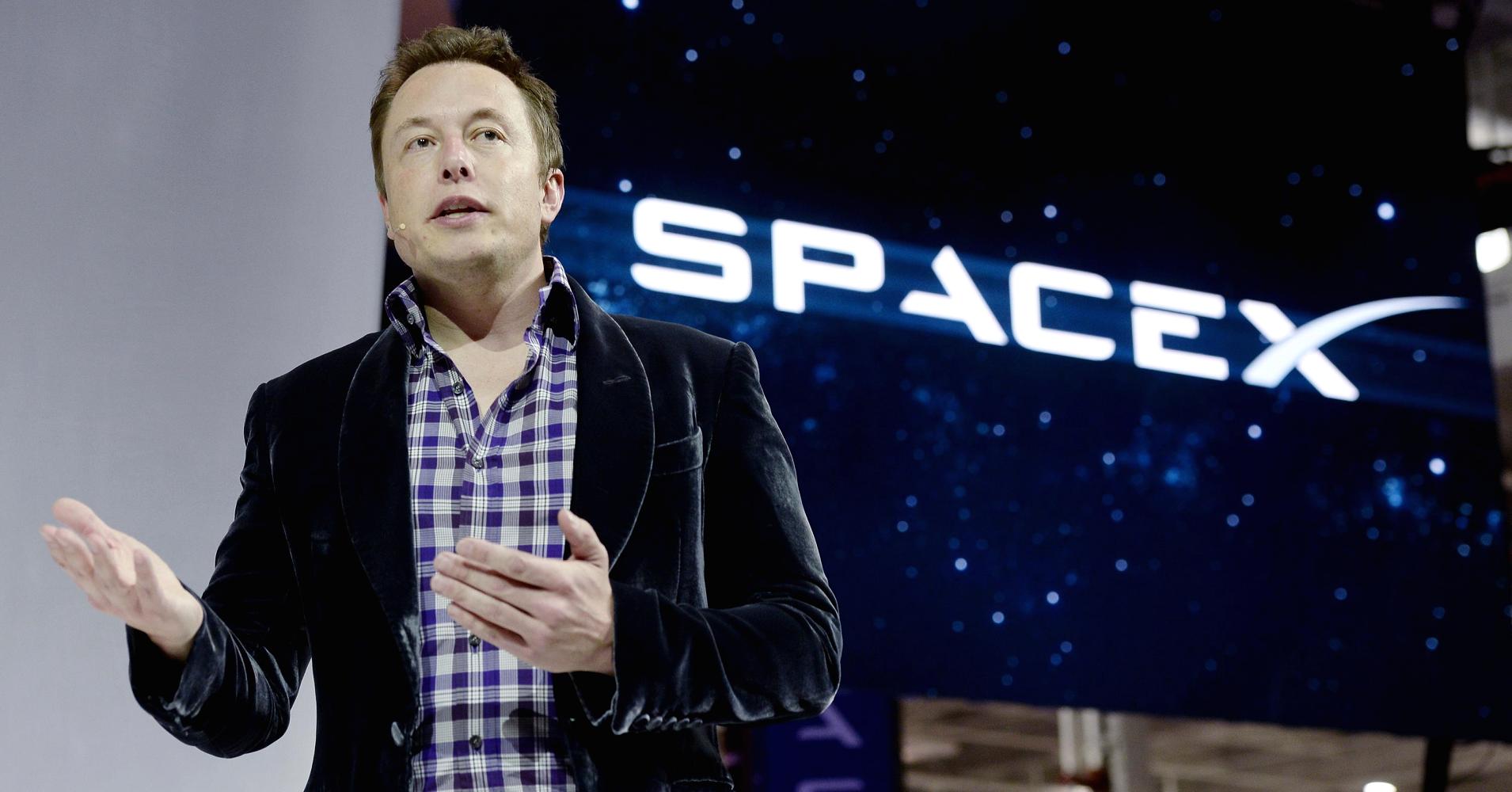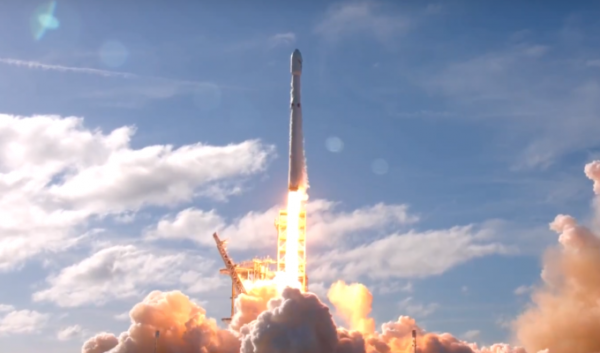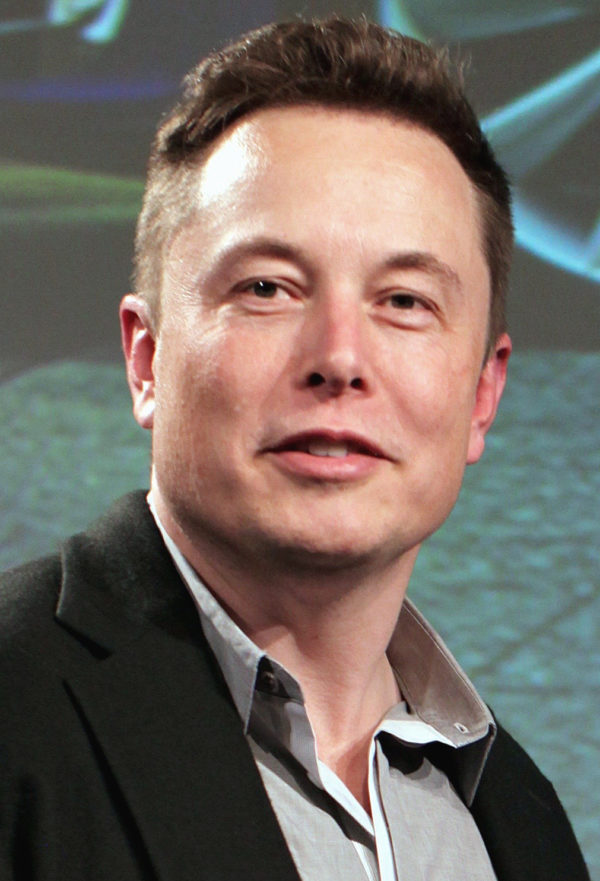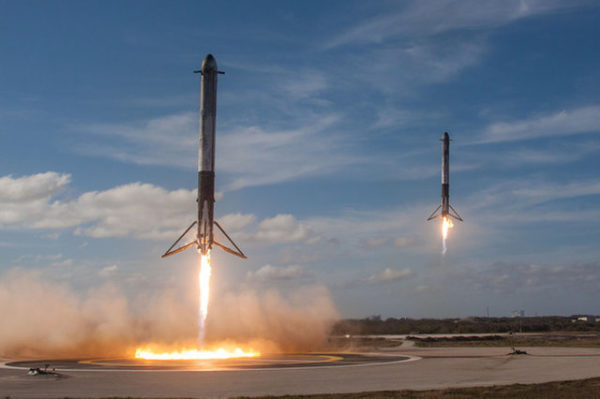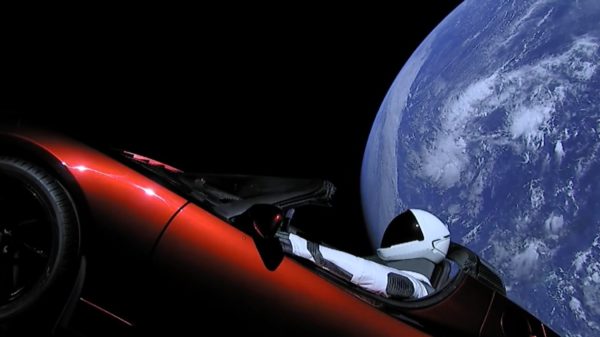Elon Musk Enroute to Mars
On February 6th, billionaire entrepreneur Elon Musk sent his old red Tesla Roadster into orbit to the Asteroid Belt, complete with a mannequin driver dubbed “Starman” and David Bowie’s “Life on Mars” playing on an endless loop. The SpaceX CEO, listed by Forbes magazine as the 53rd richest man in the world, has become obsessed with establishing a colony on Mars, and has spent a considerable amount of his vast fortune, estimated at nearly $21 billion, on achieving that goal.
Tuesday’s launch from the Kennedy Space Center at Cape Canaveral was an unqualified success, boosting hopes that Musk may yet attain his dream. Termed the Falcon Heavy rocket, the propulsion system is the most powerful since the space shuttle, currently outstripping the #2 contender, the Delta IV Heavy, with more than double the power at a third of the cost. Essentially three of SpaceX’s workhorse Falcon 9 rockets strapped together, the system’s 27 Merlin engine power source is capable of boosting 64 tons of material into orbit, but the test launch was risky, and Musk himself only gave 50-50 odds on its success.
But the Falcon Heavy boosted its payload into an orbit estimated to exceed that of Mars, into the Asteroid Belt, and performed ably on re-entry, with two of the boosters returning safely to the launch pad, landing virtually simultaneously, a sight Musk himself described as “probably the most exciting thing I’ve ever seen, literally.” A third booster stage, which attempted to rendezvous with a drone ship at sea, missed the target and was destroyed on impact in the Gulf of Mexico. The ability to reuse the boosters allows Musk to cut costs dramatically, giving him an edge in the increasingly competitive market of low-Earth orbital payloads, such as communication satellites and telescopes.
Innovation and excellence are the hallmarks of Musk’s career. Born in Pretoria, South Africa on June 28, 1971 (no time available), the Canadian American taught himself computer programming at the age of 12. After attaining two degrees from the University of Pennsylvania, Musk dropped out of the PhD program at Stamford to found Zip2, a web software company bought by Compaq in 1999 for $340 million. Musk channeled the proceeds into the creation of X.com, an online payment company, which after merging with Confinity in 2000 became PayPal, bought by eBay in 2002 for $1.5 billion. In the same year he founded SpaceX, an aerospace manufacturer and space transport services company, for which he is CEO and lead designer, followed in 2003 by Tesla, Inc, an electric vehicle and solar panel manufacturer; Musk operates as its CEO and product architect. All by the age of 32.
Musk has gone on to inspire or found several other companies and nonprofits, focusing on neurotechnologies and artificial intelligence. He has proposed and designed a new high-speed transportation system, the Hyperloop, capable of a top speed of 760 mph (which theoretically cuts the Los Angles-San Francisco commute to 35 minutes), and the Musk electric jet, with vertical take-off and landing capacity.
What accounts for such success and inventiveness? Musk’s 6 Cancer Sun is paired with asteroid Eros at 10 and Mercury at 14 Cancer, and is involved in a T-Square with Uranus at 9 Libra and asteroid Icarus at 12 Aries. Sun/Eros conveys enthusiasm and “passion” for whatever intrigues the native, focused on thought and intellectual development, via Mercury. The square to Uranus grants invention and innovation, as well as aligning Musk with futuristic applications, space travel and flight in general. Icarus reiterates the theme of flight, and adds an element of risk-taking. (Alongside Icarus is asteroid Merlin at 13 Aries, the name given to SpaceX’s rocket engines developed for their Falcon line. Merlin itself also conveys a “magical” facet to Musk’s personality via its square to the Sun, with the prolific entrepreneur seemingly able to create new companies from nothing, like pulling a rabbit out of a hat.) Unwilling to conform to the confines of tradition or expectation, Musk’s focus is on shattering barriers (Uranus) and exceeding practical limits (Icarus), defying conventional wisdom (Mercury/Uranus square).
His obsessive focus and highly personalized approach to developing technologies to combat global warming, while simultaneously creating the “escape hatch” of Mars colonization, self-avowedly to reduce the risk of humanity’s extinction, can be seen in a close conjunction of asteroids Ellen (closest match to “Elon”) and Fanatica at 17 and 15 Virgo, possibly conjoined by the Virgo Moon, which ranged from 5 to 17 Virgo the day of his birth (since one’s own PNAs are typically in contact to the Sun, Moon or Ascendant of the birth chart, I expect Musk was born later in the day, to accommodate that pattern.). Ellen/Fanatica stimulates a passion, even compulsion, for his interests which reiterates the Sun/Eros conjunction, and allows intense concentration and hyper-motivation. These form a T-Square with natal Venus at 19 Gemini, suggesting a strong affection for his work, a real love of what he is doing, and asteroid Spacewatch at 15 Sagittarius, representing SpaceX and Musk’s fascination with space in general.
Asteroid Muskau, closest to “Musk”, widely opposes the Sun from 29 Sagittarius (conforming to the PNA pattern described above); its connection to the Galactic Center at 26 Sagittarius is an indicator of a potential for global influence or notice. Muskau squares Pluto at 27 Virgo, making Musk a transformational figure, one with the power to dramatically alter the status quo, perhaps with far-reaching results. And in what area particularly can we expect to see the utmost impact for Musk? That question may be answered by asteroid Stargazer, at 29 Virgo, conjoined Pluto and exactly squared Muskau. Musk’s obsessive focus on the heavens (Stargazer) has the greatest potential to foster change (Pluto). Muskau is also exactly trined to asteroid Tesla, the name of Musk’s car company, at 29 Aries, which itself lies semisextile to career-ruling Saturn at 1 Gemini. Opposing Saturn is Neptune at 0 Sagittarius; Musk is a dreamer in his career goals, which have a definite spiritual underpinning.
Another space-related asteroid, Spacesora, appears at 1 Leo, in combination with asteroids Child and Falcone at 2 and 3 Leo. The Falcon rocket is Musk’s baby for sure, and with asteroid Kennedy just a cosmic spit away at 26 Cancer, we see the venue for SpaceX’s launch site.
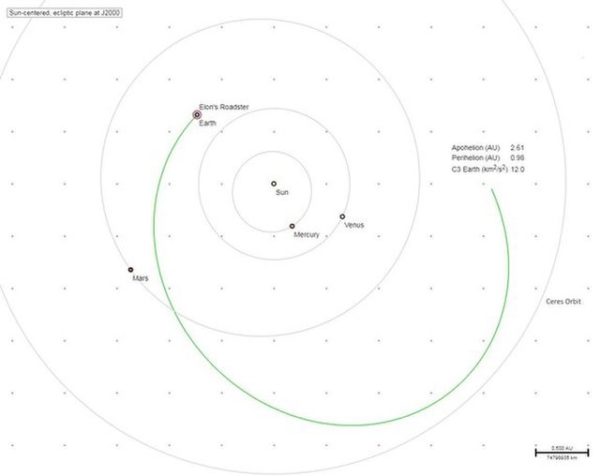
Musk’s Tesla Roadster will likely pass Mars’ orbit, perhaps venturing as a permanent satellite in the Asteroid Belt.
The fascination for Mars is evident in its natal placement. At 20 Aquarius, Mars is slowing to a standstill in the heavens, less than two weeks away from its retrograde station, an embedded element in Musk’s psyche. It is also part of a Grand Trine with Venus at 19 Gemini, again showing an attraction for all things Martian, and a combination of asteroids Pandora, Hybris and Atlantis at 16, 21 and 25 Libra respectively. Together these form a sort of cautionary tale for Musk’s Mars wanderlust. Pandora is noted for the release of unintended consequences, borne of insatiable curiosity; Hybris, the root of our word “hubris”, advises against unfettered arrogance and pride; and Atlantis warns of the dangers of uncontrolled technology run amok. Mars is also squared Jupiter at 27 Scorpio, granting fame and renown, and sesquiquadrate the Sun, making the red planet a part of his core identity.
When the Falcon Heavy lifted off from the Kennedy Space Center launch pad at 3:45 PM on 6 February 2018, celestial factors supported the venture. Asteroid Falcone at 21 Capricorn conjoins Pluto at 20 and the Descendant at 18 Capricorn. The transformative nature of the event is clearly shown here, but with Pluto involved, it could have gone another way, as a devastating loss. Musk himself opined that he had misgivings: “I had this image of just a giant explosion on the pad, a wheel bouncing down the road. But fortunately that’s not what happened.” These points also square transit Uranus at 24 Aries, once again representing space flight and innovative approaches to problem-solving. The angular contact shows the importance of the moment, with the Falcon Heavy rocket in prominence.
Just below the horizon is a grouping of asteroid Spacesora at 1 Capricorn, with an exact Saturn/Muskau conjunction at 5 Cap. This shows Musk as very much the master of the situation, at yet another career apex (both Saturn), involving his space fetish (Spacesora). Mars at 6 Sagittarius conjoins asteroids Karma at 5 and Kennedy at 10 Sagittarius; clearly, this thrust at the red planet (Mars) was fated (Karma), and meant for the Space Center (Kennedy). These square transit Ellen at 4 Pisces, itself widely conjoined Neptune at 12 Pisces. The dreamer’s dream has become a reality. Asteroid Stargazer at 5 Aries conjoins the 8 Aries MC, making Musk, in his guise as America’s premiere commercial stargazer, the focus of all eyes in that moment.
As if to underscore the point, asteroid Spacewatch is exactly conjoined Jupiter at 21 Scorpio, bringing fame and renown to the project, and this squares a solar stellium comprised of Mercury, Tesla, the Sun, Fanatica and Venus, at 10, 16, 18, 19 and 24 Aquarius respectively. This combines news (Mercury), the focus of the day (Sun), a surrogate asteroid for Musk (who, up till now, has been noted primarily as CEO of Tesla, Inc), his obsession (Fanatica), and a positive outcome (Venus, known as “the Lesser Benefic”; Jupiter, “the Greater Benefic”, is also involved by square). The Moon at 8 Scorpio squares Mercury, bringing massive public and Media attention to the event. Note also that these cluster about Musk’s natal Mars at 20 Aquarius, bringing high focus to his Martian colonization project. The upcoming Solar Eclipse at 27 Aquarius next week is very broadly conjoined natal Mars as well, granting further emphasis. Mars is also tightly bound up with the subsequent Solar Eclipse at 18 Leo, in August 2018, bringing Musk’s Martian passions into even greater prominence.
Obviously, this is not the last we’ll hear of Elon Musk.
And what of that cherry red Roadster, now beginning its own trek about the sun? If it makes it to the Asteroid Belt, survives the solar radiation and remains in a stable, trackable orbit, it will become the first man-made body to do so. I propose we name it “Elon Musk”; astrologically, it could become a symbol for unfettered genius.
